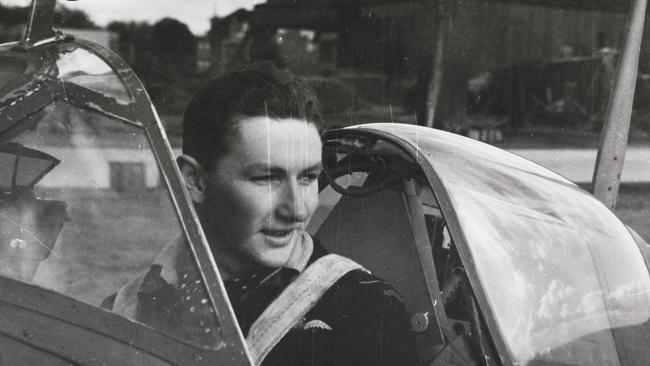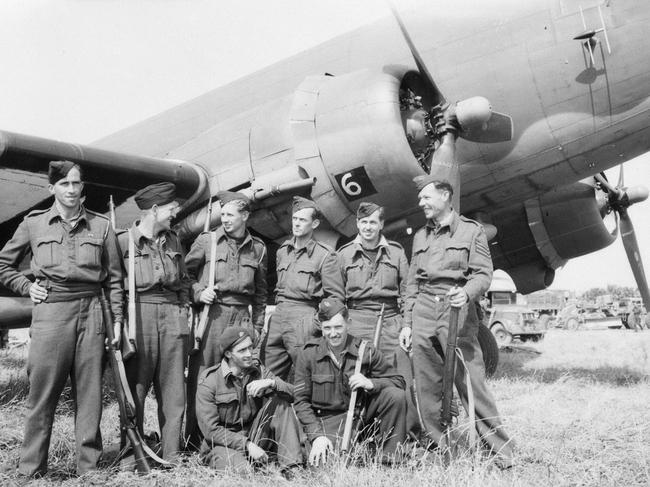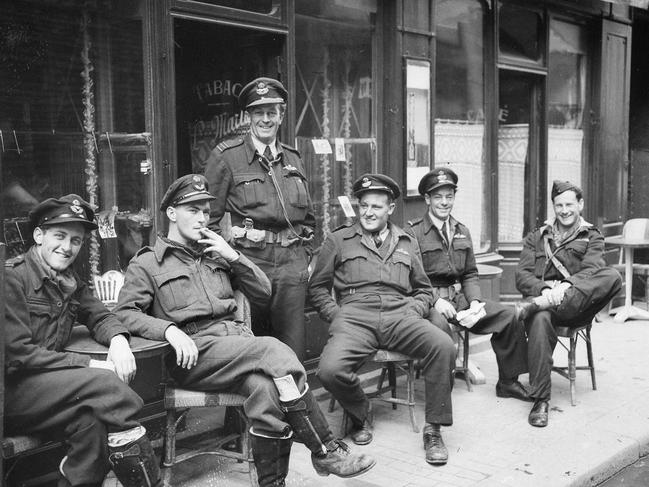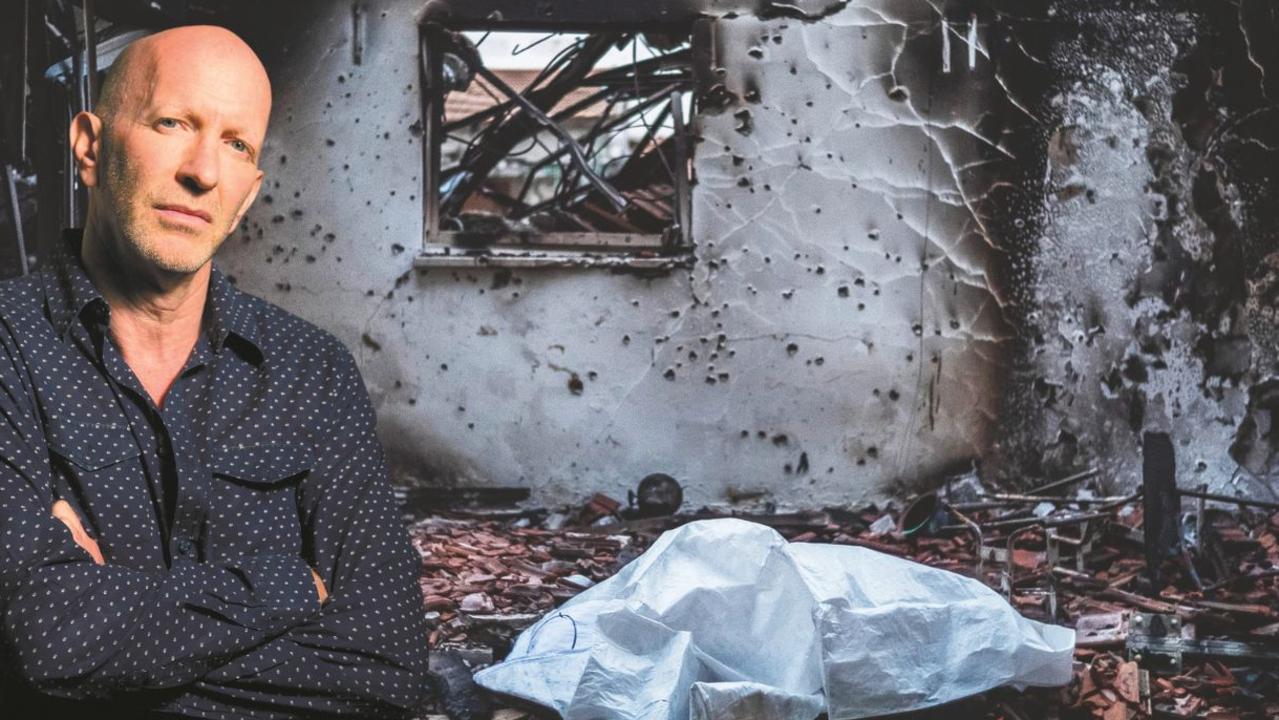RAAF’s daring D-Day pilots
Australian pilots from No 453 Squadron flew Spitfires over Normandy 75 years ago.

In late April 1944, an Australian pilot in England wrote home excitedly about the anticipated Allied invasion of Nazi-occupied Europe. “You have no idea of the feeling in the air,” he told his family. “It is electric.”
Flying Officer Russell “Rusty” Leith, then an instructor in a training unit, wanted to be part of the invasion. “If you were here you would realise why I am dying to get back to the squadron,” he wrote.
He rejoined the Royal Australian Air Force’s No 453 Squadron in July in Normandy, France, only to be forced down behind German lines three weeks later.
Leith was one of several thousand Australians who participated in the Normandy campaign. More than 2800 airmen, about 500 sailors and a small number of soldiers fought on June 6, and 13 died. Many more, however, served and suffered in the subsequent campaign in Normandy. Australia’s contribution to D-Day, June 6, has largely been overlooked.
Students and a florist
Equipped with the Supermarine Spitfire Mk IX, No 453 Squadron usually had a complement of 16 operational aircraft with two or three in reserve, and 25 pilots. These young men, with an average age of 23, came from a variety of backgrounds. There were university students and clerks as well as farmhands, labourers, a grocery assistant, a radio mechanic and an apprentice boilermaker. Seven had served in the army before joining the air force and another had been a schoolboy cadet.
Their commanding officer, Squadron Leader Donald Smith, 28, was the squadron’s most experienced pilot. A South Australian farmer, he had flown in the defence of Malta in 1942. He was credited with several successes before being shot down and severely wounded. In April 1944 he was awarded the Soviet Union’s Medal for Valour — an unusual accolade for an Australian.
Stationed in Ford in west Sussex, southern England, the squadron flew fighter sweeps over northern France, escorted bombers and attacked ground targets. In an atmosphere of growing anticipation, a diarist on June 6 noted everyone was up early:
“Pilots out of bed at 0400 hours for dawn readiness … all night we heard bombers going over to France. There must be thousands of them. The pilots took off at 0800 to give cover to the invading forces … all day long all work was accompanied by the roar of bombers overhead. We are glad we are not Germans.”
The Allies dominated the skies. US fighter aircraft patrolled the sealanes to Normandy and provided high-level cover over the invasion beaches. RAF Spitfire squadrons, including No 453 Squadron, flew low-level cover. Six Spitfire squadrons were over the beaches at any time: three over the Americans on beaches codenamed Omaha and Utah, and three over the British and Canadians on Gold, Sword and Juno.

Smith led three of the squadron’s four formations. Seven other pilots flew three sorties each and 10 flew two each. The mental and physical strain was exhausting. Strapped into the Spitfire’s tight cockpit, the pilot’s head was only centimetres from the canopy, his shoulders almost touching the runners. Constantly alert, the pilot’s eyes itched from the strain of searching the skies, his leather helmet soggy from perspiration, his stiff muscles cramping.
On June 10, Warrant Officer Keith Daff, a pre-war florist from Victoria, was the first man from the squadron to land on French soil. Engine trouble forced him down on an emergency landing strip at Vierville, but he was quickly in the air again. US soldiers had warned him of German snipers, Daff afterwards remarked to a war correspondent, and he had been more nervous on the ground than he had ever been in the air.
This was the first of several escapes. On June 27, three days after his 24th birthday, Daff was hit by anti-aircraft fire. A month later, another hit from flak severed part of his Spitfire’s propeller. Not all were as fortunate.
Late in the evening of June 11, the squadron was patrolling over Ouistreham when Flight Lieutenant Henry Lacy Smith’s Spitfire was hit by flak. Losing speed and height, his plane emitting white fume trails, Smith called over the radio telegraphy: “I am going to put this thing down in a field.” But his aircraft struck a canal, skidded on along the surface and then nosed into the water, flipping over on to its back to partly submerge. His Spitfire in the Orne River was not discovered until November 2010. Smith was buried with military honours in April 2011.
Downing the Luftwaffe
On June 16, 1944, No 453 Squadron scored against the Luftwaffe near Caen, claiming two Messerschmitt Bf 109s destroyed, two probable destroyed and one damaged. There were also losses, including a pilot killed in an accident in England.
By the end of June, the squadron had moved to Normandy, establishing itself at Longues, south of Gold Beach, on an advanced landing ground. Primitive and dusty, these landing grounds were bulldozed through crops, hedges, and ditches. The ground crew — half Australian and half British — worked 16-hour days to keep the aircraft serviceable.
French farmers and villagers greeted the airmen with calls of “Bonsoir Australie” whereas others seemed amazed the pilots were Australian. Some pilots received flowers as well as German helmets and belts as souvenirs. The Australians learned enough French to buy fresh milk, and met a villager who had proudly fought alongside Australians in World War I.
During a patrol on June 27, Flight Lieutenant Vernon “Lanc” Lancaster’s section of four Spitfires engaged eight German Focke-Wulf Fw 190s, with Lancaster claiming one probable hit. Several other German aircraft were thought damaged, but later that evening Lancaster and another pilot were “bounced” by six Fw 190s. Canon fire blew Lancaster’s Perspex windscreen to pieces. Wounded in the head and neck, the 25-year-old Victorian quickly fired a long burst at another Fw 190, which burst into flames and dived towards the ground.
The most dramatic action occurred a week later, on July 9, when more than 40 German fighters were spotted west of Lisieux. Squadron Leader Smith said calmly over the radio, “Look up and you’ll see something nice”, before the 12 Spitfires climbed to attack the Germans head on. “We simply spearhead through them,” he said afterwards.

The melee was over in minutes. Smith claimed a Bf 109 destroyed and an Fw 190 damaged. Warrant Officer Daff and two others also claimed successes. Daff gave a frank description of shooting down an Fw 190.
“I fired at him from about 200 yards (180m) and saw a bit come off his tail plane. Then I scored hits on his fuselage and he went into a slow, gentle roll before corkscrewing down. I saw the flutter of a parachute, and as I watched it opened up and glided right down on top of the burning plane.”
Germans harried
Heavily outnumbered, German fighter pilots such as Oberleutnant Willi Heilmann knew they were fighting impossible odds. Leading a squadron of Fw 190s based outside Paris, Heilmann later described the situation as “futile” and “hopeless”. The Germans would be airborne for only a few minutes before Allied fighters came in from every quarter. Neither skill nor the “craziest bravery” could prevail: the order of the day was to just “stick it out”.
As the air campaign continued, No 453 Squadron, along with British and US squadrons, focused on smashing the Germans’ line of communications, dive-bombing and strafing their vehicles and interrupting their flow of supplies and reinforcements. The Australians hunted up to 60km behind the German front lines. An Australian newspaper described an occasion when a flight of four Spitfires spotted a single German military policeman directing traffic. The pilots “riddled the luckless Nazi with their machineguns” before attacking the vehicle convoy.
Another report had an Australian pilot flying so low to “shoot up” a German staff car that when the Spitfire returned the aircraft’s Perspex windscreen was covered with the blood of the car’s occupants. As the fighting ground on, the squadron’s tally of destroyed armoured vehicles, lorries, wagons and staff cars, described as “flamers”, “smokers” or “damaged”, continued to climb.
Constantly harried, the Germans sought what protection they could. They stopped moving in large numbers and started driving vehicles in short stages, darting from tree to tree. There were rudimentary attempts at camouflage, with some vehicles carrying tree branches. Smith admitted that the chief hazards to low-flying Spitfires were the anti-aircraft guns. “The Hun” had “substituted flak for fighters”, he noted.
Flak was the greatest killer of No 453 Squadron’s pilots. In addition to Flight Lieutenant Lacy Smith, three others were killed as a result of flak in July, and a fifth was killed in August. Many more were shot down, a few on multiple occasions.
Other pilots fell victims to cruel twists of fate. Warrant Officer Kenneth “Kenny” Kinross was one of the squadron’s more experienced pilots. The son of a Great War veteran, Kinross joined the RAAF in 1941. On July 24, 1944, he was one of four Spitfires returning from a patrol over Bayeux, Caen, and Cabourg when a US Army Air Force P-47 Thunderbolt appeared and opened fire. Kinross’s Spitfire was hit and plunged into the ground, killing the 22-year-old pilot. The American disappeared as suddenly as he had appeared.
Shortly after moving to another airfield near Lingevres, a disastrous incident occurred on August 14 when a single German aircraft dropped three anti-personnel bombs among the pilots’ tents and near the officers mess. Warrant Officer Mervyn Watson was killed a day before his 21st birthday. Originally a plumber and tinsmith in northeast NSW, he had joined the squadron in mid-June. Three other pilots were seriously wounded, including one who had been with the squadron for only five days.
Miracle landing
On August 16, Warrant Officer Fred Cowpe’s Spitfire was hit by flak near the cockpit. He was shot through both legs and his emergency dinghy caught fire. He later described what happened in his diary: “Slid hood back and cocked door, noticed seat and most likely chute was riddled with flak fragments … Suddenly I’m on fire, it pouring up and out through open canopy … pain excruciating, trying to beat off flames with left hand … suddenly all pain gone (found out later, when nerves burnt through, pain ceases) … ground hit with a mighty crash … Got out and trying to beat out clothing, British soldiers helping me and carried away from aircraft … looked at my left gauntlet, it was charred and burnt black. Thought … it’s no good now so pulled it off, but in so doing skin and flesh came off with it.”
Despite suffering second-degree burns, Cowpe had managed to land on a recently captured airfield.
Warrant Officer Roderick “Froggie” Lyall, 22, had a remarkable escape. A student from Victoria before the war, he was hit by flak on July 12 and crashed southeast of Falaise. After two days on the run, he was caught by four members of the German SS and was kept in various prison camps near Alencon.
Wearing American clothes over his RAAF uniform, Lyall and an American jumped from a moving truck and escaped into the night. Hidden by French villagers near Saint-Denis-sur-Sarthon, the two airmen were picked up by US soldiers on August 13. Five days later Lyall was back with the squadron, now based near Lingevres. A second pilot, missing since early July, also returned to the squadron, followed by Leith on August 25. All three men owed their escape and survival to the bravery of the French farmers who hid them at great personal risk.
Boosting morale
The safe return of these evaders was a welcome boost to the squadron’s morale. July had been costly, particularly towards the end of the month when over four days eight pilots were lost — four killed and four shot down. These were heavy losses for a small, close-knit group fatigued by the stress and strain of combat. Consequently, the squadron’s medical officer used a 24-hour break from operations as an opportunity to throw a party.
Hosted by a nearby British military hospital, the Australians enjoyed beer, scotch, gin, and dancing with the nurses. A diarist observed how the night helped break the gloom caused by recent losses. A fortunate few also took brief respites in Britain, either on leave or to ferry replacement aircraft to France.
By the end of August, the last German troops had withdrawn across the River Seine. In September, British and US forces continued advancing through northern France, and later Holland. During two patrols near Arnhem on September 27, No 453 Squadron again outfought the Luftwaffe.
In the first action, Warrant Officer Lyall claimed a Bf 109 destroyed. During the second patrol a Spitfire was brought down by flak, but the pilot was seen running towards a Dutch village. The patrol went on to engage a large formation of enemy fighters. Four Australians pilots, including Leith, each claimed a Bf 109 destroyed. Four more were claimed damaged. The next day, the squadron received a new commanding officer as Smith, along with Flight Lieutenant Lancaster, completed his tour of 200 operational hours.
On September 29, the squadron’s Spitfires flew back to Britain. They encountered heavy flak over Ostend, Belgium, still held by the Germans, with Flying Officer James “Fergie” Ferguson taking a direct hit. Turning inland, his Spitfire exploded a few seconds later. All assumed he was killed. Ferguson, however, wounded slightly and suffering burns, had bailed out and became a prisoner of war.
Final toll
From June until September, No 453 Squadron had flown 2354 operational sorties, clocked up 3176 operational hours, claimed 20 German aircraft destroyed, and destroyed five German armoured and 162 transport vehicles.
Eight pilots were killed, eight were wounded or injured, and three became prisoners of the Germans.
The squadron had a small role in a much larger struggle, but the efforts of the Australians had not been mere tokenism, nor were they passive observers. The pilots and ground crew of RAAF’s No 453 Squadron had been skilful combatants in the great crusade that eventually liberated Western Europe from Nazism.
Karl James is head of the military history section at the Australian War Memorial.


